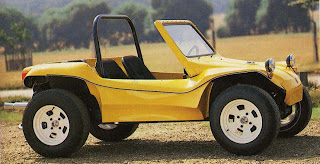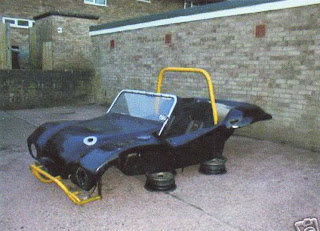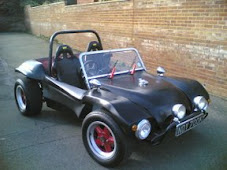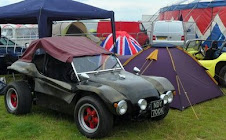30th May 2008
I had already cleaned up my A-arms and spring plates by sending them away to be media blasted and then zinc plated and rebuilt them with their respective bearings and axles. With the A-Arm mounts welded in place and the gearbox made to fit the frame horns I was ready to re-build the read suspension. I decided after a great deal of debate that I would refit all the bearings with the Urethane type. Popular research at the time indicated that the Urethane substance was good as a bearing surface and stronger than the rubber alternatives. I ordered two A-Arm Urethane bushes and new spring plate bushes in Urethane and two new cover plates. The all arrived from SSP quite promptly.
I started with the Urethane A-Arm Bushes These are quite easy to install and can be pressed into the arms with a reasonable sized vice or cramp. SSP does not sell its bushes with Urethane grease and It is fairly common knowledge that normal motor grease will slowly wear the Urethane bushes faster.
Once I had the bushes in place I was able to put them aside and make a start on putting in the spring plates. The inner bushes where pressed onto the inner side of the spring plate and then the knobbly outer was placed on and driven onto the spring plate with a wooden mallet. I had previously bought a digital level and had used this to set up some angles on the A-Arm brackets. This had proved to be a good method and as I new that the spring plates should be set at 20 degrees I found them fairly easy to get set up in the right position. I set up both sides so that they spring plates where pushed in tight . They needed lifting over the bottom of the block on the torsion bar end. This should really be done with a special tool to lift the spring plates. I used small luggage straps around the suspension arm and the spring plate. These are the ratchet type that can allow you to ratchet up the spring plate to maneuver it over the bottom hump so that it can be driven in with a mallet further into the torsion tube. Once the spring plate had been hit into position so that it fits into the shell at the end of the torsion tube. You can fit the spring plate cover with the four bolts before releasing the straps. This can be repeated on the other spring plate . The shorter spring plate design makes the force needed to pull up the spring plate more than the amount usually used.
With the spring plates fitted the A-Arms can be pushed into their brackets with the bolt pin securing them. This allows the washers to be placed in situe. i placed a washer ether side of the bush. Some people seem to place the washers on the same side but I figured the washers should be placed on either side.
With the bolts pin loosely done up I was able hoist the A-Arm up so that it was at the same height as the spring plate. This allowed the three bolts to be placed in the holes and tightened up to 11kg m or 80 lbs ft. With the spring plate bolts torqued up you can use an Allen key 87 lb ft 12 kgm.
Next I would have to install and make up the drive shafts.
IRS Conversion - Part three
28th April 2008
 Even though I had the jigs fitted onto the car and the brackets looked good I decided that I would like to check the measurements that the brackets where angled up towards and compare them with each side.
Even though I had the jigs fitted onto the car and the brackets looked good I decided that I would like to check the measurements that the brackets where angled up towards and compare them with each side.
First I had to level the car up as the axle stands that I had at the rear of the car where positioning the front of the car lower than absolute horizontal. I used a 2 ton car jack under the front beam to raise the car up to level as indicated on my digital level.
positioning the front of the car lower than absolute horizontal. I used a 2 ton car jack under the front beam to raise the car up to level as indicated on my digital level.
After taking readings on each bracket I found that they where nearly the same 0.02 degrees out. I hit the lower on with a sledge hammer and it came back to the 5.10 degrees on the other side.
After some research into pricing the cost of hiring a generator welder that would be cost efficient to to hire for two days . It was soon apparent that the cost of doing so was going to cost more than it was to hire a qualified welder with a generator welder!
Several ph one calls later after scouring the Yellow Pages I found a man that had a portable generator welder that was used to welding farm, equipment. he quoted me no more than £100.0
one calls later after scouring the Yellow Pages I found a man that had a portable generator welder that was used to welding farm, equipment. he quoted me no more than £100.0 0 to do the welding.
0 to do the welding.
He turned up and soon began welding. It was soon apparent that his welding skills with his equipment where far more superior than his.
The brackets welded on easily the work I had done ensuring a good fit had made it a quick job to weld up. My welder used wire rod to weld in the holes under the brackets where I had cut out to much. I have read several articles regarding the installation of these brackets and it seems that this is quite a routine problem experienced by people attempting this conversion.
I trial fitted the gearbox an soon found that I would have to remove material from the frame horns where it interfered with the IRS joint. I measured the distance from the ground to the frame horns and braced the frame horns with timber between the horn and the axle stands. I would use this measurement later to ensure that the frame horns had not moved position.
I bought a 2000 degree blow torch powered from a propane tank. I used this to heat up the frame horns so that thy could be hit and reshaped with an assortment of different weight hammers. (Note here ensure that your propane regulator is correct . Do not let anyone sell you a regulator without trying the torch out on it.)
The metal was very malleable when heated and I found it easy to reshape it. I retried the gearbox and decided that I would need little more room between the IRS joints. I removed the gearbox and started at the frame horns again. This time I got them to the same profile and painted them up with red oxide and then primer and paint.
The assembly of the gearbox A-Arms and spring plates was next.
 Even though I had the jigs fitted onto the car and the brackets looked good I decided that I would like to check the measurements that the brackets where angled up towards and compare them with each side.
Even though I had the jigs fitted onto the car and the brackets looked good I decided that I would like to check the measurements that the brackets where angled up towards and compare them with each side.First I had to level the car up as the axle stands that I had at the rear of the car where
 positioning the front of the car lower than absolute horizontal. I used a 2 ton car jack under the front beam to raise the car up to level as indicated on my digital level.
positioning the front of the car lower than absolute horizontal. I used a 2 ton car jack under the front beam to raise the car up to level as indicated on my digital level.After taking readings on each bracket I found that they where nearly the same 0.02 degrees out. I hit the lower on with a sledge hammer and it came back to the 5.10 degrees on the other side.
After some research into pricing the cost of hiring a generator welder that would be cost efficient to to hire for two days . It was soon apparent that the cost of doing so was going to cost more than it was to hire a qualified welder with a generator welder!
Several ph
 one calls later after scouring the Yellow Pages I found a man that had a portable generator welder that was used to welding farm, equipment. he quoted me no more than £100.0
one calls later after scouring the Yellow Pages I found a man that had a portable generator welder that was used to welding farm, equipment. he quoted me no more than £100.0 0 to do the welding.
0 to do the welding.He turned up and soon began welding. It was soon apparent that his welding skills with his equipment where far more superior than his.
The brackets welded on easily the work I had done ensuring a good fit had made it a quick job to weld up. My welder used wire rod to weld in the holes under the brackets where I had cut out to much. I have read several articles regarding the installation of these brackets and it seems that this is quite a routine problem experienced by people attempting this conversion.
I trial fitted the gearbox an soon found that I would have to remove material from the frame horns where it interfered with the IRS joint. I measured the distance from the ground to the frame horns and braced the frame horns with timber between the horn and the axle stands. I would use this measurement later to ensure that the frame horns had not moved position.
I bought a 2000 degree blow torch powered from a propane tank. I used this to heat up the frame horns so that thy could be hit and reshaped with an assortment of different weight hammers. (Note here ensure that your propane regulator is correct . Do not let anyone sell you a regulator without trying the torch out on it.)
The metal was very malleable when heated and I found it easy to reshape it. I retried the gearbox and decided that I would need little more room between the IRS joints. I removed the gearbox and started at the frame horns again. This time I got them to the same profile and painted them up with red oxide and then primer and paint.
The assembly of the gearbox A-Arms and spring plates was next.
Labels:
A-Arm Bracket
Subscribe to:
Posts (Atom)


















